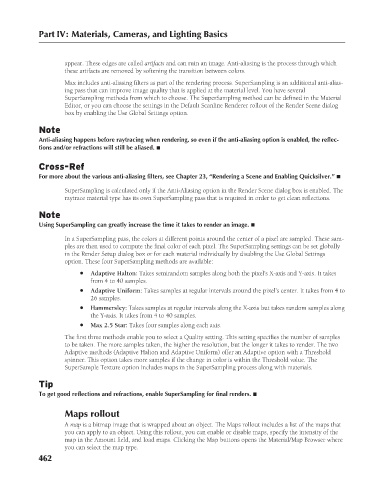Page 510 - Kitab3DsMax
P. 510
Part IV: Materials, Cameras, and Lighting Basics
appear. These edges are called artifacts and can ruin an image. Anti-aliasing is the process through which
these artifacts are removed by softening the transition between colors.
Max includes anti-aliasing filters as part of the rendering process. SuperSampling is an additional anti-alias-
ing pass that can improve image quality that is applied at the material level. You have several
SuperSampling methods from which to choose. The SuperSampling method can be defined in the Material
Editor, or you can choose the settings in the Default Scanline Renderer rollout of the Render Scene dialog
box by enabling the Use Global Settings option.
Note
Anti-aliasing happens before raytracing when rendering, so even if the anti-aliasing option is enabled, the reflec-
tions and/or refractions will still be aliased. n
Cross-Ref
For more about the various anti-aliasing filters, see Chapter 23, “Rendering a Scene and Enabling Quicksilver.” n
SuperSampling is calculated only if the Anti-Aliasing option in the Render Scene dialog box is enabled. The
raytrace material type has its own SuperSampling pass that is required in order to get clean reflections.
Note
Using SuperSampling can greatly increase the time it takes to render an image. n
In a SuperSampling pass, the colors at different points around the center of a pixel are sampled. These sam-
ples are then used to compute the final color of each pixel. The SuperSampling settings can be set globally
in the Render Setup dialog box or for each material individually by disabling the Use Global Settings
option. These four SuperSampling methods are available:
l Adaptive Halton: Takes semirandom samples along both the pixel’s X-axis and Y-axis. It takes
from 4 to 40 samples.
l Adaptive Uniform: Takes samples at regular intervals around the pixel’s center. It takes from 4 to
26 samples.
l Hammersley: Takes samples at regular intervals along the X-axis but takes random samples along
the Y-axis. It takes from 4 to 40 samples.
l Max 2.5 Star: Takes four samples along each axis.
The first three methods enable you to select a Quality setting. This setting specifies the number of samples
to be taken. The more samples taken, the higher the resolution, but the longer it takes to render. The two
Adaptive methods (Adaptive Halton and Adaptive Uniform) offer an Adaptive option with a Threshold
spinner. This option takes more samples if the change in color is within the Threshold value. The
SuperSample Texture option includes maps in the SuperSampling process along with materials.
Tip
To get good reflections and refractions, enable SuperSampling for final renders. n
Maps rollout
A map is a bitmap image that is wrapped about an object. The Maps rollout includes a list of the maps that
you can apply to an object. Using this rollout, you can enable or disable maps, specify the intensity of the
map in the Amount field, and load maps. Clicking the Map buttons opens the Material/Map Browser where
you can select the map type.
462
6/30/10 4:24 PM
24_617779-ch16.indd 462 6/30/10 4:24 PM
24_617779-ch16.indd 462

